Of all the wonders in the Argentina, one of the most impressive is the peak Aconcagua, which earned the nickname “Sentinel of America” for its 6962 meters high, which position it as the highest mountain on the continent.
The Aconcagua is located in the locality of Las Heras, which can only be accessed by car through provincial route 7 (3 hours of travel) from the capital of Mendoza.
Mount Aconcagua has different faces for its ascent, some relatively easy, others on the contrary truly for experienced mountaineers.
In all cases, it is necessary to hire the guide service and do the group ascents, always following the rules of the mountain, many of them They were conceived and rethought from the experience of their climbers.
Below you will find a guide with all the information for that you take into account when venturing towards the great Sentinel from America:
What activities can be done on Aconcagua
Trekking to the summit
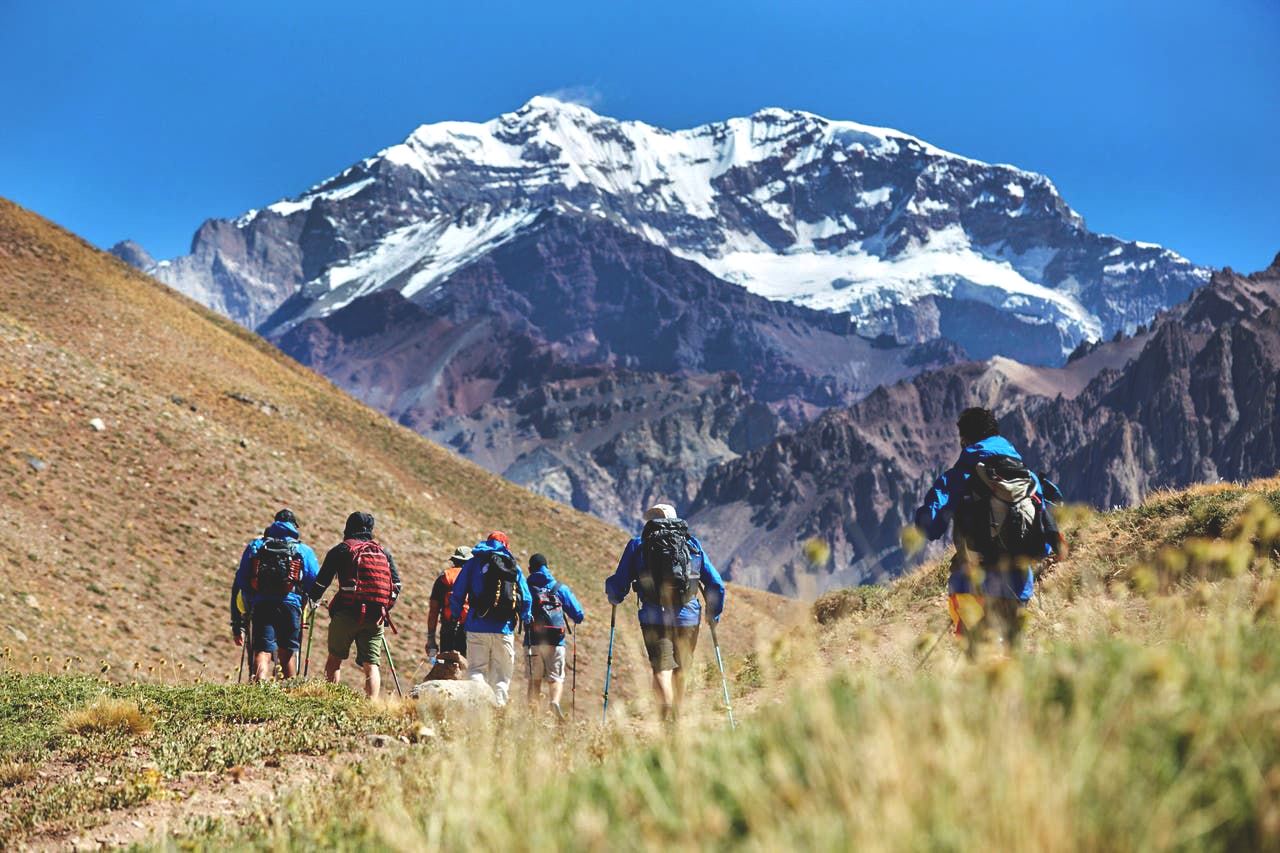
The so-called “Normal way” is to ascend the north face of the hill, the experience begins at the Puente del Inca (entrance to Aconcagua National Park, 1,900 meters). On this route no climbing techniques are needed but rather a stealth and constant trekking that is enlivened with the use of poles, in addition to all the essential equipment to climb.
Those who start the famous "Normal route" go through different mountain camps, where they rest until they are in adequate physical condition to continue climbing. Keep in mind that as you ascend, oxygen decreases significantly, so it is necessary to acclimate to these changes.
Is recommended to do it in the different camps that I detail below: Base Camp (also known as Plaza de Mulas) a 4,300 meters, El Semáforo, Piedras Conway, Plaza Canada, La Piedra at 5,000 meters, Change of Slope, Nest of Condors at 5,250 meters, a wide sector where the rocks serve as protection against the wind, here you can also see small frozen lagoons.
Following the tour will arrive at the Berlin camp (a shelter with capacity for 6 people), Piedras Blancas, Piedras Negras, Independencia, Portezuelo de los Vientos . In the latter, the strong currents of the Pacific begin, winds that go from 60 to 100 kilometers per hour, which makes it difficult to walk and be able to stay upright. Then follows the Great Crossing and the last one before the summit: La Canaleta at 6700 meters. These last 300 meters are with a large slope of loose rocks that make the ascent very difficult.
This last last section must be done with crampons, it is the most demanding and extremely careful point. The Canaleta must be approached from its left side, climbing through small glaciers as far as the Cuesta del Guanaco, the ridge that separates the two summits (the South 6,950 meters and the North 6,962 meters). In this area, an estimated oxygen deficiency is 30% to 40% of normal. But all the effort will have its great reward when reaching “the roof of the Andes”.
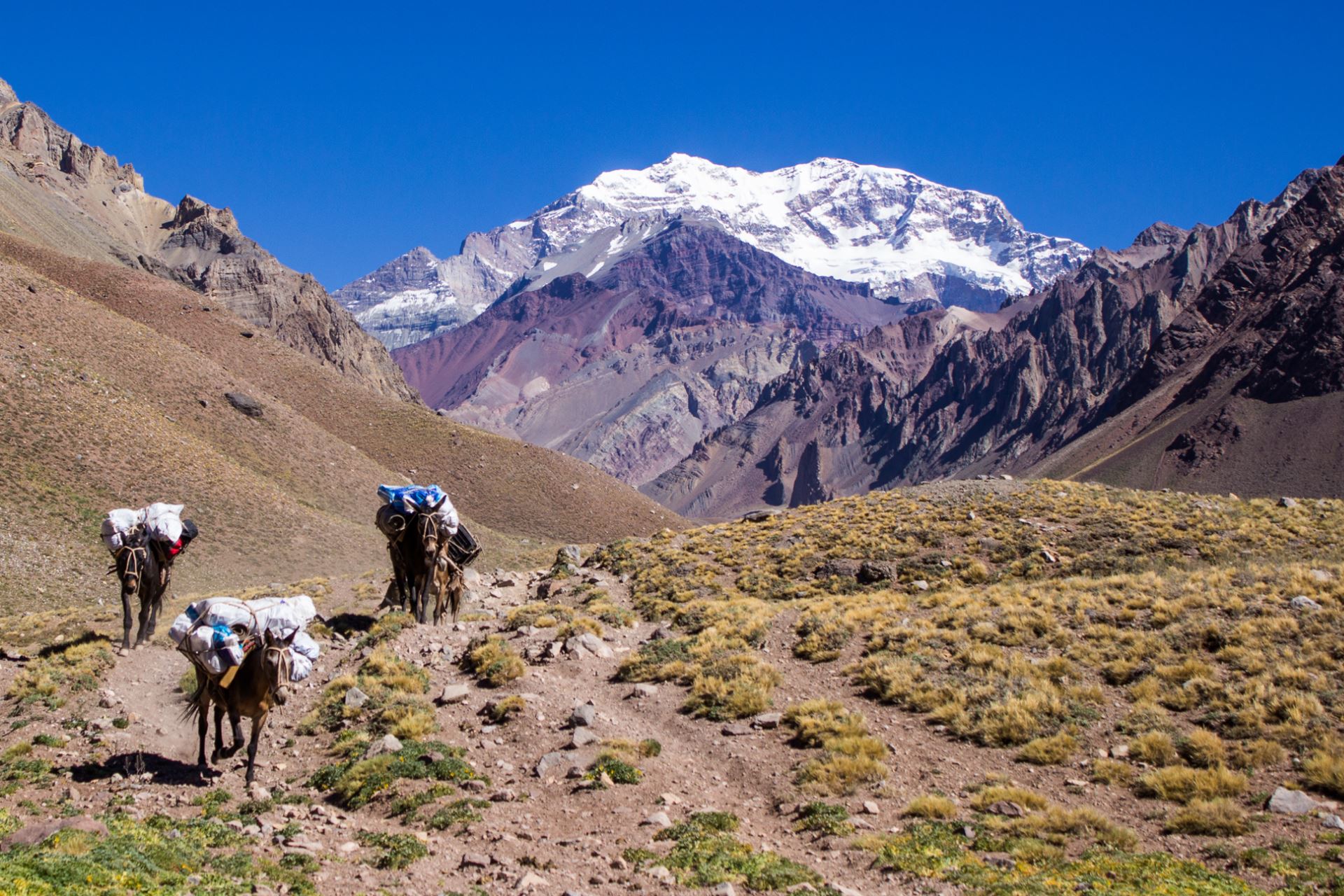
To make the ascent by the “Via Normal” or North Face of Aconcagua, it must be taken into account that it is a gravel path of 40 kilometers (from Laguna de los Horcones) it takes at least 15 days to climb to the top, including acclimatization time to altitude.
The other ascent route called “Glaciar de los Polacos” is only visited by experienced climbers. The path towards this it is done taking the Valley of the Cows. It crosses to the base of the Polacos Glacier and from there it crosses the path of the Normal Route, but in this case a final climb begins to the summit. This technically demanding trail is 76 kilometers long.
The “South wall” is the most difficult access road to the summit on Aconcagua. There are 78 kilometers and Its maximum difficulty materializes when it ends in one of the largest walls in the world (3000 meters of wall). Getting up this route is really something for a select few, it is a very committed climb and technique for rocks, ice and glaciers.
The first ascent of the South Wall was made on February 25, 1954 by Frenchmen Pierre Lesueur, Adrien Dagory, Edmond Denis, Robert Paragot, Lucien Berardini and Guy Poulet. The head of the expedition it was René Ferlet.
For the descent, it is usually calculated half the time that has been used for the rise. However, many times exhaustion causes that time to lengthen, so you should anticipate the duration of this while ascending.
Spot the Aconcagua fauna
Some of the animal species that you can spot in the area are the red foxes, guanacos, which are usually stalked by the puma , the largest predator in the area. There are also mountain mice, squatters and other sedentary species such as lizards, lizards and Andean toads (this is of special interest, since it indicates the purity of the water in the area). The most abundant species are European hares, being an exotic feral animal in the region.
As for the birdlife of the place is diverse, there are more than 60 types of birds, some very small like the Andean hummingbird and other larger ones such as the falcons, the Matamicos and the emblematic Andean condor.
The species most adapted to human presence are the comeebo, camineras, viudita, gauchito and chingolos, commonly seen in the lower camps of the park. The meadows, streams and rivers are populated by aquatic birds like crested duck, torrent and headband plover.
Discover the flora of Aconcagua
Most of the vegetation and animal life survives below the 4,000 meters of altitude of Aconcagua, since the climatic conditions in the upper areas are extreme.
High mountain vegetation adapts to these conditions, taking advantage of the hottest season (December to March) to bloom and reproduce, so during the tour you will be surprised with a flowering that, mostly, it covers the surface with yellow hues.
To shelter from the wind and cold, as well as the strong summer sunshine, some plants have a squat appearance and cushion-shaped bushes such as yareta, hornbeam. goat and yellow firewood.
In the area you will also be able to observe that open grasslands such as huecú and coirones predominate. The inert rocks that reach up to 4,300 meters, provide shelter to some perennial herbs such as the quirquincho tail and the cockade. The melt streams that run down the slopes feed small meadows and wetlands of green pastures called “vegas”, locally known as the “arid Andes jungle.” They can also be seen reeds, sedges and other species of grasses.
Yellow Firewood It is the most representative plant of the Aconcagua area. It is also known as the pinwheel or coli-mamil (Adesmia pinifolia), it is the largest in the park. It is a thorny shrub, with a trunk thick, in some cases it can reach 3 meters in height. Its branches are yellow bark (hence one of its common names).
It is characterized by having deciduous foliage, leaves composed of fine linear yellowish-green leaflets and small hidden spines . Its flowers are small, yellow in color grouped in clusters that bloom from late November to January (depending on the weather) and its fruit is a hairy legume.
Although it is very slow growing, the age they reach is surprising, exceeding the 150 years. They build their nests some birds such as baskets and chingolos; and it is a refuge for various rodents and reptiles. Sleepers, fio-fios, gauchitos, yales and falconcitos perch on its high branches to hunt and feed. Being resistant to snow cover, it is very useful in avalanche retention. In occasional storms they serve as a refuge for muleteers, tourists and animals.
Hiking through Aconcagua Provincial Park
For those who want to know part of the Aconcagua environment and its base, doing the trekking through the Aconcagua Provincial Park is an excellent option. In addition to the mountaineering routes that allow you to ascend to the top of Aconcagua, the Provincial Park offers numerous circuits with different levels of difficulty.
The walks along these circuits invite you to pass through landscapes of snow-capped mountains, deep valleys with panoramic viewpoints and mighty rivers. Some of these routes correspond to gentle 2-hour hiking trails, while other more complex ones comprise 7 days of trekking.
There is the possibility of hiring a guide service to perform the hiking in the Aconcagua Provincial Park, it is recommended if you do not have previous experience, or want to know every detail and path of this wonderful natural environment.
In the 73 thousand hectares covered by the park it can be observed that a shrub, stunted or creeping vegetation predominates, and in the areas near the peaks the vegetation dominant is the shrubby steppe, low and scattered, with a predominance of iros, which are hard compact shepherd plants, generally yellowish.
Regarding the fauna of the Aconcagua Provincial Park, you can see the condor that with a wingspan close to three meters and a height that when perched exceeds 90 centimeters It is considered the largest flying bird, it flies over the valleys and hills of the area with extraordinary skill. It is the great protagonist of the area!
Continuing with the group of birds, you will be able to locate the Muscisaxicola cinerea that frequents the proximity of mountain rivers and streams, the Andean comosebo with a showy dark cap that contrasts with the ventral part yellow-white, el yal plomiso, the collared squat whose name refers to the custom of "squatting" against the ground.
Another characteristic animal of the area is the guanaco whose capacity to live in steep terrain is greater than that of the vicuña, there are also populations of the emblematic puma and red fox.
Tour the Laguna de Horcones circuit
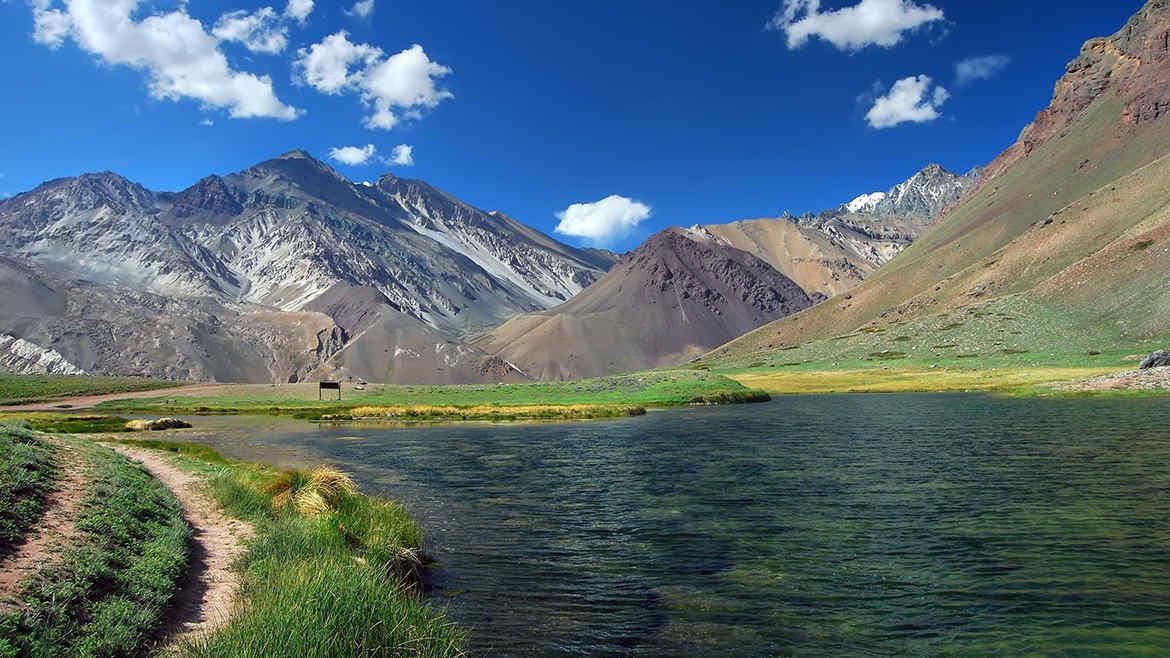
It is the most important water mirror in Aconcagua Park, this lagoon is created by the melting of the glaciers that are in the surroundings and also feeds on the meltwater of Cerro Tolosa.
The Laguna de Horcones nbsp ; it is located 2,950 meters above sea level, it is part of a small wetland formed by five lagoons and meadows; these wetlands are characterized by presenting a biological diversity of plants and animals. The valley was covered during successive periods by large glaciers.
The Laguna de Horcones circuit is a route of almost 2 kilometers nbsp ; distance that can be covered in one hour. It is the only path that is allowed to be done throughout the year, unlike the ascents to the summit or the trekking to the base campsthat have well-defined seasonal dates.
It is a low-demand trekking trail that can be done as a family and allows you to see the southern wall of Cerro Aconcagua with its hanging glaciers. In this tour you can see how the water, the wind and the glaciers were shaping the Horcones Valley, you can also see the Aconcagua Viewpoint and various formations of glacial origin.
The Horcones Visitor Center is open every day from 8 am to 5 pm, it is located at the entrance to the park. There you must pay the ticket of the self-guided circuit. It is important to bear in mind that to carry out this circuit you must wear warm clothing, sun protection and sports shoes, as well as mineral water. Food is not sold in Aconcagua Park.
When to ascend Aconcagua
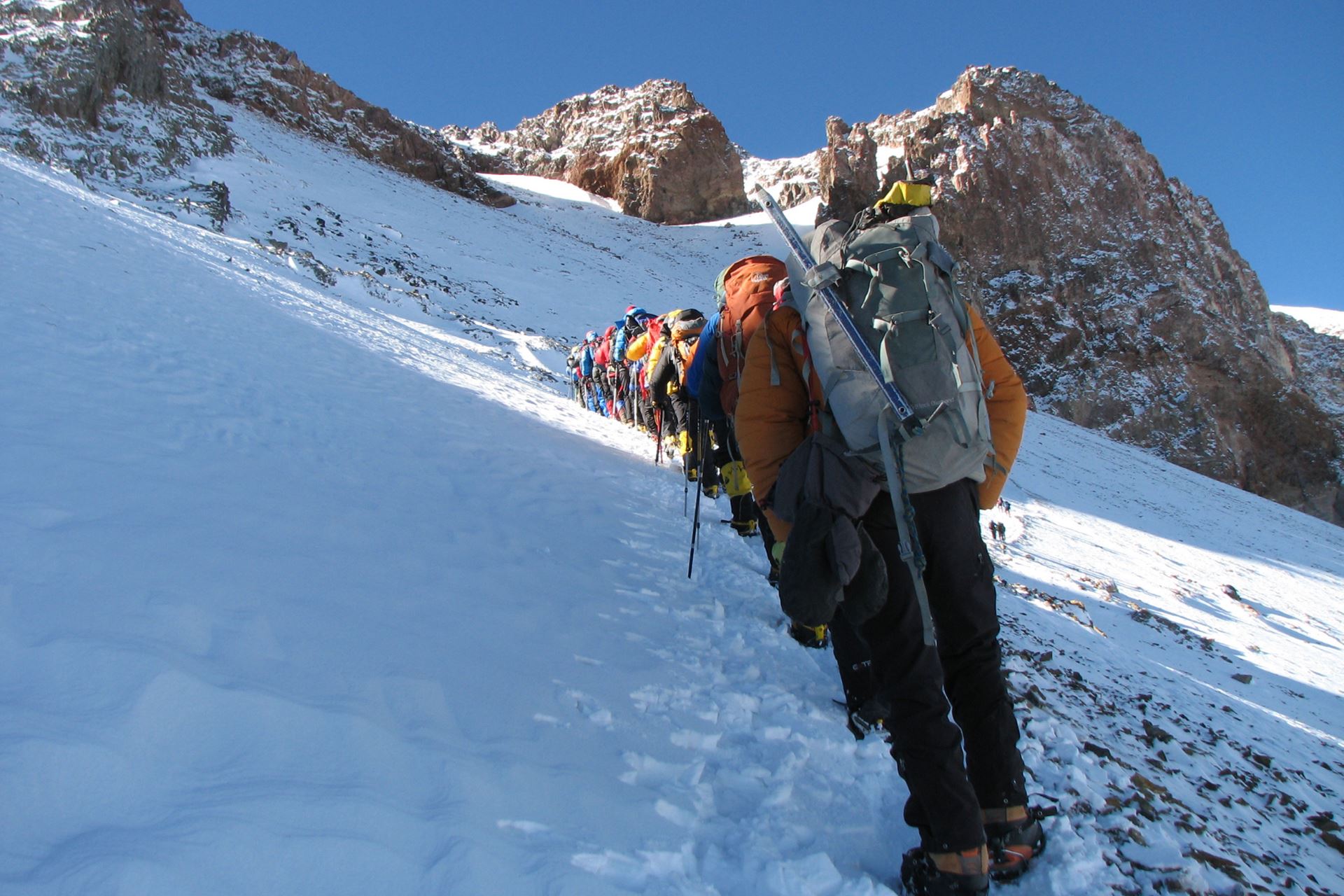
The expedition is officially between November 15 to March 31 of each year, being December 15 to January 31 the high season.
The suggestion for those who wish to venture to Aconcagua is to do it between the end of November and the end of February, since there are two factors: first due to the weather conditions. of these months when the climate is warmer in the Southern Hemisphere and more stable in Aconcagua.
The second factor is that there is greater availability of the services necessary to carry out the ascents (mules, base camp services and porters).
Before or after the recommended season, there is a very low number of visitors in Aconcagua Park and it is very likely that you do not have the necessary logistics services to face this demanding excursion.
Regarding the climate, outside the recommended season there are heavy snowfalls, strong winds and wide fields of ice and snow that cover both the access to the base camps and the ascent routes.
During the summer (December to March), you can experience the temperature at night in places that reach the 5,000 meters of approximately nbsp ; -20 ° C, and the temperature at the top is -30 ° C.
Cold, snowy, and unpredictable conditions make most attempts to reach the top during winter dangerous.
The humidity is quite scarce, the oxygen is low and there are very strong winds that are at the same time responsible for producing important storms in the place.
What equipment to use in high mountains
The technical equipment necessary to make the ascent to Aconcagua is one of the most important points to face this challenge, since in most cases it avoids injuries and health problems that could prevent you from complying with your goal of reaching the summit.
That is why when choosing clothing, take into account the following items:
- First skin: This clothing is in direct contact with the skin and its function is to wick away sweat, keeping the skin dry. This type has two characteristics: it maintains body heat, but is permeable to air, which also allows a feeling of freshness. Ideally, the material of this layer should be polyester. The use of cotton garments is not recommended, since they maintain humidity and help reduce body temperature. First-skin garments are pants, T-shirts, gloves and socks.
- Second skin: This clothing is placed on the 1st skin and its main function is that of thermal insulation, maintaining the heat generated by the body and favoring the moisture evacuation. This skin is made up of different types of fabrics, the most common being polar. The garments of this layer are pants, jacket or pullover, vest, hat, gloves and socks.
- Third skin: This layer must be completely waterproof, breathable and windproof. The combination of these qualities will make, in a storm or river crossing, the water does not penetrate the garments but, at the same time, allows sweat to escape. In mountain areas, staying dry and warm will be synonymous with comfort and health. The garments made of this skin are pants, jacket, hat and gloves.
Remember that 30% of body heat is lost through the head, so it is essential to have good warm hats, balaclavas (polypropylene or capilene) and neckerchiefs.
-Fourth skin: This last layer is, specifically, thermal insulation. The clothing can be filled with feather or fiber and is used in very cold temperatures (from -10 ° C to -35 ° C). This leather garments can be a jacket, vest or overalls.
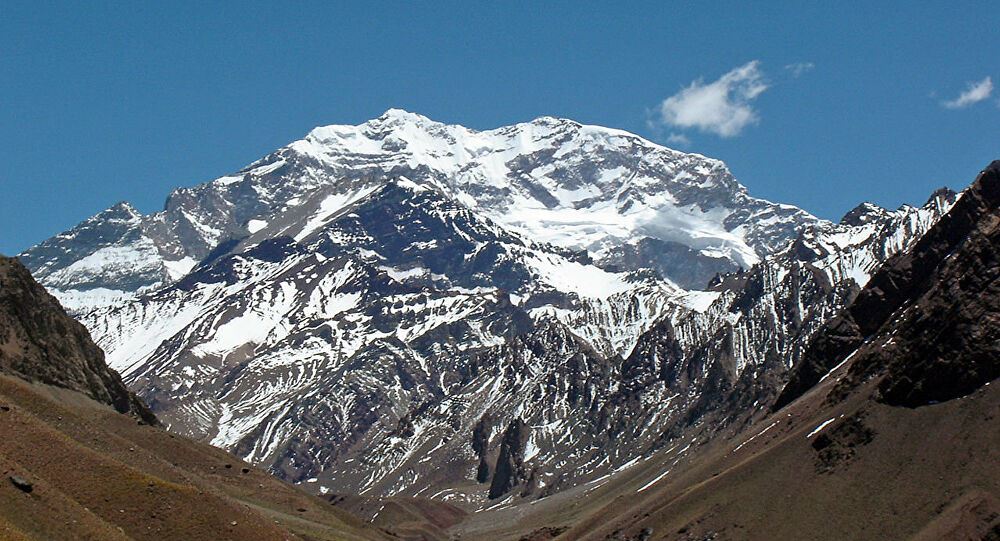
On the footwear side, this is a fundamental element when facing the ascent of a hill. This must have different qualities such as shock absorption, versatility and coat.
In the case of Aconcagua, trekking boots can be used up to Nido de Cóndores or to Plaza Argentina. From here, it is essential to ascend with double or triple boots, these are the only ones that will avoid the feet frostbite.
There are also accessories that cannot be missing for the ascent:
- 12-point crampons ; light pegs/ice axes (only in Glaciar de los Polacos).
- Canes.
- Backpack for expedition of 120lts approx. and attack backpack (for the summit day) from 20 to 40lts.
- Headlamp and spare batteries.
- Sunglasses with 100UV sun protection, with side covers (two pairs).
- Duvet sleeping bag , that supports up to -30ºC.
- Insulating mat.
- Tent (height).
- Heater (gasoline or gas) and spare parts (one spare per day for one person and one and a half spare per day for two people is calculated)
- Freeze-dried food.
- High factor sunscreen and lip balm.
How to get to Aconcagua from Mendoza
The Aconcagua is within the Provincial Park located 185 kilometers from the City of Mendoza. Accessible renting a car and heading towards the National Route N ° 7 until the signs that mark the entrance to the park. It is approximately 3 hours of travel.
Another option is to take a bus from the terminal in the center of Mendoza (Av. Acceso Este and Av. Videla) la Buttini mic line towards Uspallata and once at the local terminal, take the taxis located at the entrance to the entrance of the Aconcagua Provincial Park (73 kilometers).
To start the trekkings and ascent to Aconcagua is mandatory register online, request permission and do the payment of the entrance fee. For the walk to Laguna los Horcones online registration is not necessary. It is done in the visitor center of the Provincial Park.
For the trails it is mandatory to carry ID or passport, sports shoes, shelter, sun protection, food and drinking water. There is no sale of food in the park!
If you want to reserve accommodations in Mendoza, excursions or travel package, contact us!